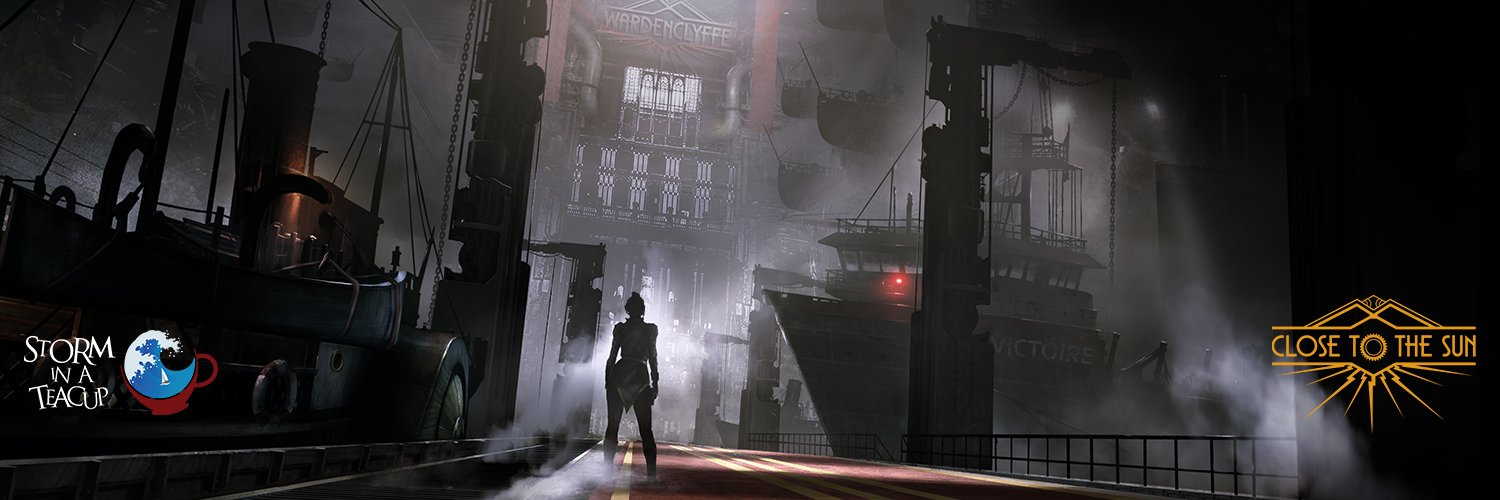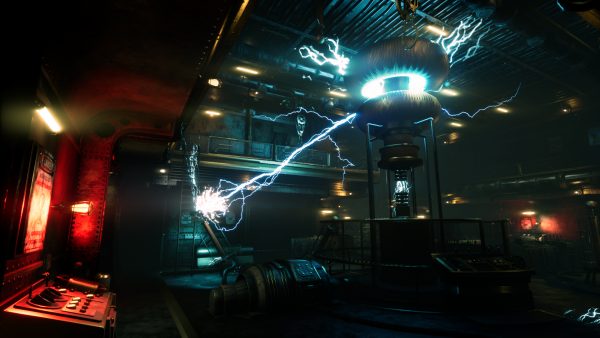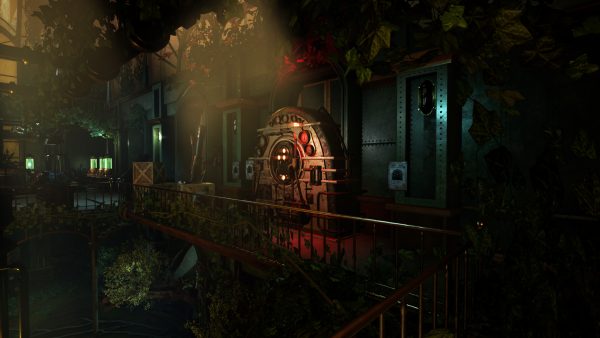
Incoming Gaming Editor Alex Green chats to Joel Hakalax from Storm in a Teacup about the team’s most recent game: Close to the Sun, a first-person horror adventure set on-board a ruined scientific utopia.
When EGX Rezzed rolled around many single-player games reared their heads, looking to impress a new, perhaps more indie-minded crowd of players… a tricky task as always. Having a demo of a single-player game at a convention means the player struggles to glean too much into the overall experience, the pacing of the story and how the demo’s mechanics will play out over a full game. However, some games have a spark that no matter how little you play, they have a certain aspect that immediately draw you in. Fair to say that, with their new horror title Close to the Sun, Storm in a Teacup have such an idea.
Ahead of EGX Rezzed, one game drew me in. A glance at Close To The Sun shows the hallmarks of many great atmospheric single-player games. Some slightly lazy comparisons of Bioshock and Prey come to mind but sitting down to play the demo reveals a far more enticing world beneath the surface-level visual design. A world in which Nikola Tesla won his feud with Edison and created a haven for great scientific minds. A mystery to uncover with varying ways of showing it and even some solid puzzles in a highly cinematic experience.
Close To The Sun has you taking control of Rose Archer, boarding a ship known as the Helios, in search of sister Ada Archer. The game is now out on the Epic store with a whole world to explore that is teeming with depth and a mystery to uncover. Ahead of the release, I chatted with game designer Joel Hakalax about the game’s design, the ideas behind the story and what they hoped to achieve with Close To The Sun:

Alex Green: So, I guess to start, when it came to making Close to the Sun, what was the original idea that you sort of had way back when?
Joel Hakalax: Yeah, way back when, we started brainstorming and I guess the first real pillar we wanted to focus on was isolation and being away from civilisation. So, we wanted to be out at sea. Even in modern times now if you go out to sea, rescue is very far away. But, we have this thing called GPS, phones and all kinds of modern technology to help with that. We wanted to emphasise that sense of isolation, that sense of being vulnerable and alone. So, we moved back in time to the turn of the century, of the 19th century. Doing that brought up Tesla. And as soon as we had Tesla… whatever you started poking at him, from whatever angle, something interesting would come out. So as soon as we had that, a ship out at sea and Nikola Tesla, the rest just kind of fell into place.
AG: So I assume that because of that, the game’s direction was always fairly constant, there wasn’t that many changes from the original idea ultimately, or was there a lot more changes than you would have expected?
JH: No, we knew very early on that making a shooter is beyond our budget and capabilities. We are a small indie team of 10-15 people. We’ve been working on it now for a bit over 2 years, but that was just at the limit of what we knew what we had in terms of time. So, the game hasn’t changed that much from it’s core pillars. We did lean more into the puzzle and problem-solving aspects early on in development. We toned that down a little bit to put more emphasis on the narrative and the storytelling experience. But overall, the game is very similar to what we set out to do at the beginning.
AG: The game is made with Unreal Engine 4. How was it to be able to use that and get to grips with that?
JH: Unreal has done a ton of heavy-lifting for us. It’s really refreshing to have an engine that is so robust and established that you don’t have to do that many technical battles in order to achieve your artistic vision. So it’s been great to be able to focus on making the game and not have to battle with the engine. One of the best aspects of the Unreal Engine is just the strong community. Whatever your problem is, there’s a very high likelihood that someone else has already had similar problems and solved it… you can always find a solution to your problems.
AG: So going further into that story, you mentioned the ideas of Tesla being able to be successful. That always stuck out as being a great idea just to make a world around and how fun was it to get to grips with making that world and making things like the Helios ship?
JH: Yeah, so in Close to the Sun, we play with alternate history, a world in which Nikola Tesla did not get screwed over by (Thomas) Edison. So, all of Tesla’s creative genius, all of his aspirations, all of his ambition has come to fruition. So, Nikola Tesla as a historic character was just so rich, not only in his inventions and his work but also as a personality. This feud and rivalry with Edison, for example, is just a fountain of very interesting dynamics that you can play around with and we have. So in our alternate take on history, Nikola Tesla is basically the Elon Musk of that era. Super rich, super wealthy, super successful. And he built this super-massive floating laboratory called the Helios. And aboard the Helios, he is attracting scientists from all over the world to put mankind in a golden age of scientific revolution. So Nikola Tesla, as a character, has such a wealth of drama around him that is so rich to just poke at.
AG: Having played the game, that world-building was very apparent. There’s like the movie theatre with plays of Frankenstein. Seeing as you enter the prologue and seeing this sort of empty but vast ship. What was the real challenge of making something that size and getting that across to the player?
JH: Well, since we knew early on that we wanted to do something out at sea, we set out making an ocean simulator. Because of course we’re out at sea, we’re going to need some waves. And we did make an ocean simulator that’s quite powerful. We’re selling that one as a standalone asset on the Unreal marketplace as well. But as we continued development, the size of the Helios just grew and grew and grew, so the sea lost more and more of it’s importance and it became much more important for us to dive deeper into the Helios. So, we’re not using the ocean simulator as much as we initially thought that we would, but that’s just one of the quirks of video game development, where you have to be nimble and find out what the game wants to be and deliver on that. So in terms of world building and all of that, we’ve been super luck to have such good concept artists. Because a lot of the posters, such as the Frankenstein poster and so on, really allows us to tell stories using convenient visual mediums on the walls, on the floors, and just tell an effective narrative and communicate a world without having to do it in writing. We can actually do it in interesting ways that just saves us a lot of time and, primarily, saves the player a lot of effort in terms of receiving that world.

AG: Obviously, the game is very much a story focused single player experience. I just wanted to get your thoughts on single-player games in general and how important they are to the current gaming landscape in your opinion.
JH: They’re really important as they always have been and will be in the future. I mean, games as a medium is so broad and you can do so much within the confines of games that doing the multiplayer and battle royale stuff, that’s awesome and it’s a lot of fun, but it’s not the only thing games can be. Single-player games and single-player game experiences such as Bioshock, Prey, Firewatch, SOMA, you can go in so many different directions using only the single-player framework. These types of experiences will always be with us and it’s especially as we start to venture further into VR, those experiences will just become even more profound, and there’s something about having that personal experience in that single-player confine that will always resonate with people in a way multiplayer games and similar games can’t really reach.
AG: Just out of curiosity as well, are there any ideas that were maybe scrapped or things you tried to put into Close to the Sun that ultimately, will never see the light of day?
JH: Yeah. There are casualties. You got to kill your darlings. So early on in Close to the Sun development, we were leaning into the puzzle-solving dynamic. So we had a thing called the Tesla Tube, which allowed you to establish resonance with items and machinery in your surroundings through a distance. So you could activate a light from across the room, you could enable a staircase to automatically fall down and reach you with the Tesla Tube. But that turned out to be a hassle, so that was one of the features we had to scrap in order for us to reach the level of polish the game kind of requires nowadays. Indie games have reached a certain level of quality now that if you’re not matching it, you will be forgotten. It’s really hard to make that splash that you kind of need nowadays, so polish, whether you’re AAA or indie, is important.
AG: I suppose, as well, with Storm in a Teacup having made a lot of single-player games in the past like N.E.R.O, that experience and pedigree is obviously going to be very helpful with this game, isn’t it?
JH: Yeah, I mean, there is no better teacher than mistakes. We’ve done tons of mistakes in the past, we’ll do tons of mistakes today and we will do tons of mistakes in the future. But as long as you learn from them and steadily improve, that’s just the way good games are made. So having made N.E.R.O and Enki and Lantern in the past taught us tons and without those games, we wouldn’t be at the level of polish that we are with Close to the Sun today. So we’re really proud of the games that we’ve done in the past. N.E.R.O is big, Enki and Lantern are smaller projects, but each one of them has taught us so much and I don’t know there’s a way of getting around that. Simply going through the process of pressing publish on a title, that is important. Sometimes you will be more successful than other times, but the general start to finish thing is very very important just to make sure that you get the lessons that you need to, in order to arrive at something that is of quality.
AG: Finally, when the game releases, what do you hope players will be able to get out of the game, both in a larger sense and how the game plays?
JH: I hope they have a good time. If that happens, then I’m happy. That can be defined in so many ways because some will enjoy being scared, some will not. Hopefully we will be walking that middle line of having enough tension there to keep you on your toes but not overdo it. I just hope that people will see Close to the Sun and appreciate it for what it is, an indie project made over 2 years by a small team in Rome. We’re still growing, still learning but we are trying to punch above our weight class. We’re doing our best to deliver something that you wouldn’t necessarily expect from a small indie dev. So as long as we can impress some people then I’m fine.
(Close To The Sun is available exclusively on the Epic store. Alternatively, visit their website here: http://www.closetothesungame.com/)
Comments